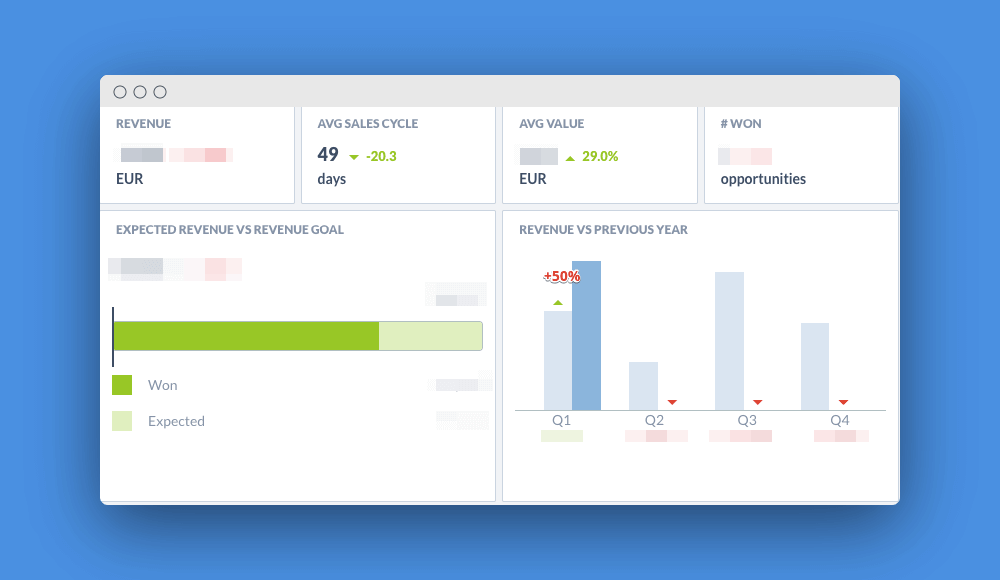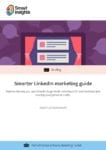In this guide, I’m going to show you how to leverage inbound marketing on LinkedIn to create a steady stream of high-quality B2B leads and accelerate your sales.
No scraping emails and outbound outreach with your inbound marketing. No mass-spamming. Just an exact step process you can follow to regularly fill in your sales pipeline with high-quality inbound leads.

Let’s get started.
Smarter LinkedIn marketing guide
For a complete overview of everything LinkedIn can do and how to set up a business page that will generate interest on the platform, download our Smarter LinkedIn marketing guide.
Access the Smarter LinkedIn marketing guide
Step 1: Define and focus on your target market segment
From a glance, this is the easiest step but, at the same time, wrong targeting makes every marketing campaign doomed before it ever started.
There is a famous Russian proverb: A person who chases two rabbits won't catch either.
Different market segments who potentially can buy your product have different challenges, goals and, accordingly, seek for completely different content.
Step 2: Create an ideal customer profile
I deliberately always write an "ideal customer profile" instead of simply "customer profile".
>You know that all leads and customers aren't equal. The real problem here is most companies never devote these customers and leads the time they devote.
Ideal customer profile helps you to collect the data from your customers from the specific market segment and focus your inbound strategy on them instead of prospecting everybody who might buy from you.
I won't dive deeply into details here as there is a great guide on the topic:
Step 3: Create a content plan
After you've finished the ideal customer profile, you have a clear view on:
- What challenges your target audience regularly faces?
- What kind of content do they consume?
- What is their typical decision-making process starting from becoming aware of the problem, to buying your product
You'd also be aware that people don't consume content on social media the same way they do on websites.
LinkedIn audience prefers easy to digest, insightful content published as a story.
That means you can't simply post "valuable" content every day - the latest trends show that everyday "how-to" content leads to the audience fatigue.
Here are my suggestions on how to create an effective LinkedIn content plan:
- Create topic clusters
- Create sub-topics.
- List all questions your target audience have that belong to specific sub-topic.
- Decide what type of content you'd post
- Create a content calendar
Here is a caveat:
Don’t share links from your website.
LinkedIn drastically decreases the organic reach of posts that lead people away from LinkedIn.
The question you might have here:
How can I generate inbound leads if I don't post links to my website and don't share my blog content?
That's what I'll reveal in a second :).
Step 4: Optimize LinkedIn profiles of content creators
An optimized LinkedIn profile is the answer to how you can generate leads from LinkedIn without sharing links to your website or blog.
An optimized LinkedIn profile means:
- You have a professional pic and look like a credible person.
- Your title underlines what you do and who might benefit from it.
- Your profile description nails the exact challenges you/your product can help with.
- You've included the next step: a clear CTA what your profile visitor should do, or, at least, your contacts.
- Your profile includes your previous background - employers, your job role, major achievements.
- You have recommendations.
Profile Lead Generation
Let me now nail the process of how to profile lead generation works.
- You publish content that attracts the attention of your target audience
- They like your content, see what you do in your title, and click on your profile to learn more.
- On your profile, they see what do you do, how you can help them, what makes you different and social proof.
- If they have an existing challenge you can solve, they reach you out or schedule a meeting.
That’s why everybody who’ll be involved in content creation and promotion on LinkedIn must have a professionally optimized LinkedIn profile.
The question is how to make the target audience seeing your content without heavily investing in paid content promotion?
Step 5: Come into sight of the target audience
There are two approaches to how you can come into sight of your target audience.
The first one is a "spray and pray" approach when you post your content and pray it will go viral or your target audience will see it.
The second one is a proactive approach when you manually create a professional network of target contacts.
The best part?
You can automate the process of building the target network.
- Open LinkedIn sales navigator and apply filters
- Open Discover Tab to see all the recommended leads
- Install a tool like MeetLeonard, Dux-Soup, or LinkedIn Helper to send automated connection requests to your target audience.
- Add a custom message
Just follow this process every day and in 1 year you’ll create a valuable network full of your target prospects.
Step 6: Post regularly
Until you become a well-known thought leader in your niche whose content audience is waiting and always engage, you'd regularly appear in the target audience's newsfeed.
There are two components of regularly coming into sight of your target audience besides valuable and interesting content.
1. Playing by the platform rules
Like I mentioned earlier, LinkedIn hates when you try to drive people away from the platform. Here are four ways how you can promote your content on LinkedIn without penalty:
- Post link in the first comment and mention at the end of the post that the link is there.
- Post a link in the comments, copy the link to the comment and include it to the post.
- End your post by asking people to comment if they are interested to read the whole content and deliver them this content manually.
- Automatically deliver the content to the people who might be interested in it.
Here is a caveat: Don’t try to spam everybody with your content or you can be blocked by LinkedIn, if people report or block you.
Only send the content to the people who can benefit from it.
2. Mixing different types of content
From my experience, if you'll only try to promote content from your blog, one day you'll see a miserable amount of people who engage with it.
That's why mixing different types of content is mandatory.
Here's what I've seen works great in B2B space.
- Professional stories that are relevant to the target audience
- Tips from your content with linking to it in the comments
- Video tips
- Asking questions
Digital strategy in a time of crisis
Discover more blogs and ways to kickstart your organization's digital transformation strategy with actionable, practical online learning that gets results, fast!
See More
Step 7: Engage with the target audience in private messages
Remember the golden rule of selling: People buy from people when they like them and trust them.
Besides the great content, what is the best way to build a relationship with a target audience?
Help them or talk about what they are interested in! This is a part of the so-called value selling methodology.
The first part should be done by a great content you regularly publish.
The second part is starting a conversation with your connections.
There are 5 situations when you can initiate a conversation.
- You get a new target connection request.
- You saw that a person who fits your ICP visited your profile
- You saw that the person who fits your ICP engaged with your content
- You saw that your target connection has a birthday, anniversary or changed a job
- You saw that your target connection posted a valuable content on LinkedIn
Just by implementing these 7 steps, you'll be able to create a stable flow of high-quality inbound leads.
Andrei Zinkevich. Andrei started his marketing career as a sales rep in 2007 and then switched to trade marketing at Kimberly Clark. In 2013 he started to work as a B2B marketing consultant and founded Getleado – a B2B marketing consulting agency. Since then, he’s helped multiple brands in IT solutions, enterprise SaaS, B2B manufacturing, etc., create an effective marketing strategy, increase pipeline, and scale revenue.
LinkedInTwitter<ahref="https://www.facebook.com/Andriy.Zinkevich">Facebook









